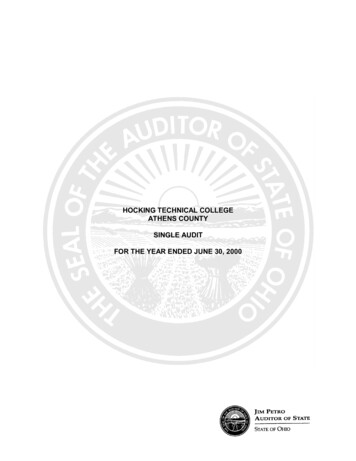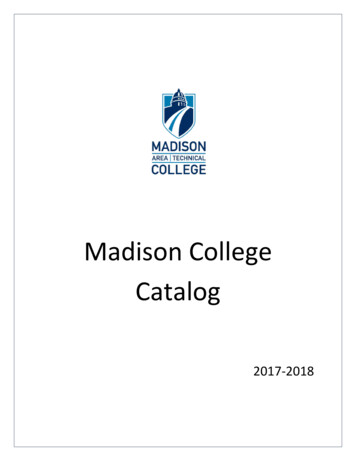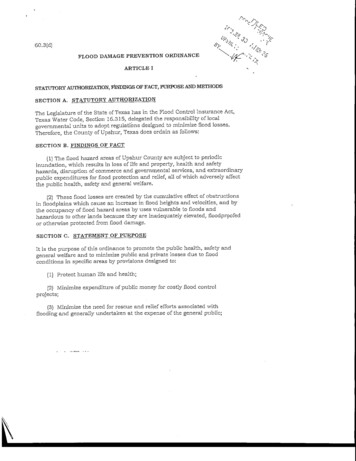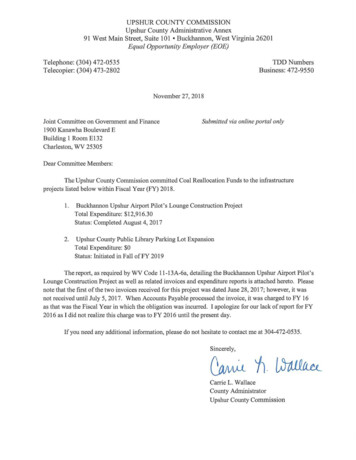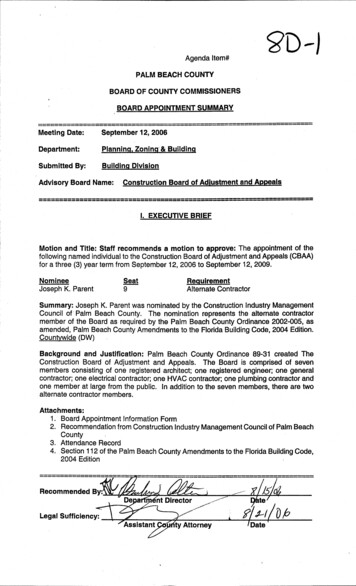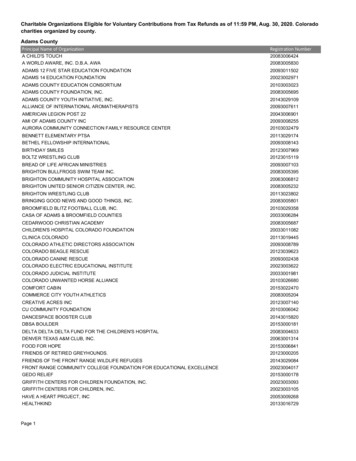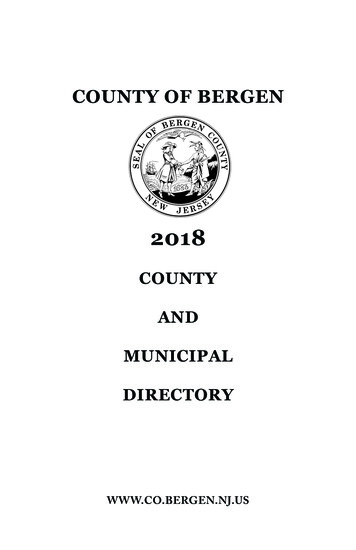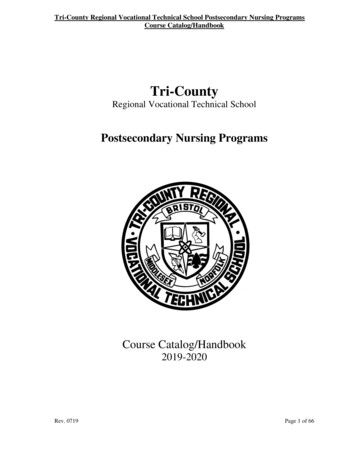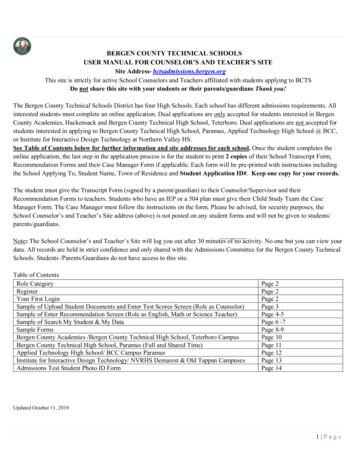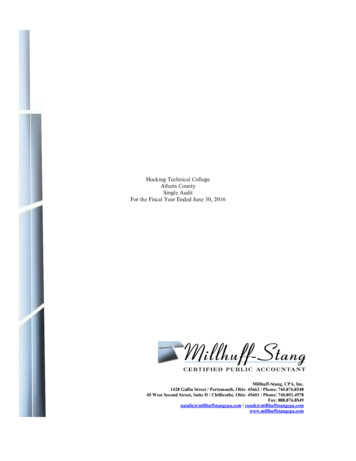
Transcription
Hocking Technical CollegeAthens CountySingle AuditFor the Fiscal Year Ended June 30, 2016Millhuff-Stang, CPA, Inc.1428 Gallia Street / Portsmouth, Ohio 45662 / Phone: 740.876.854845 West Second Street, Suite D / Chillicothe, Ohio 45601 / Phone: 740.851.4978Fax: 888.876.8549natalie@millhuffstangcpa.com / roush@millhuffstangcpa.comwww.millhuffstangcpa.com
Board of TrusteesHocking Technical College3301 Hocking ParkwayNelsonville, Ohio 45764We have reviewed the Independent Auditor’s Report of the Hocking Technical College, AthensCounty, prepared by Millhuff-Stang, CPA, Inc., for the audit period July 1, 2015 through June30, 2016. Based upon this review, we have accepted these reports in lieu of the audit required bySection 117.11, Revised Code. The Auditor of State did not audit the accompanying financialstatements and, accordingly, we are unable to express, and do not express an opinion on them.Our review was made in reference to the applicable sections of legislative criteria, as reflected bythe Ohio Constitution, and the Revised Code, policies, procedures and guidelines of the Auditorof State, regulations and grant requirements. The Hocking Technical College is responsible forcompliance with these laws and regulations.Dave YostAuditor of StateJanuary 17, 201788 East Broad Street, Fifth Floor, Columbus, Ohio 43215‐3506Phone: 614‐466‐4514 or 800‐282‐0370Fax: 614‐466‐4490www. auditor.state.oh.us
This page intentionally left blank.
Hocking Technical CollegeTable of ContentsFor the Fiscal Year Ended June 30, 2016TitlePageAppointed Officials . (i)Administrative Personnel . (ii)Independent Auditor’s Report. 1Management’s Discussion and Analysis . 4Basic Financial Statements:Statement of Net Position . 12Statement of Revenues, Expenses and Changes in Net Position. 13Statement of Cash Flows. 14Notes to the Basic Financial Statements . 16Required Supplementary Information:Schedule of the College’s Proportionate Share of Net Pension Liability-Last Three Fiscal Years. 42Schedule of the College Contributions – Last Ten Fiscal Years . 43Schedule of Federal Awards Revenues and Expenditures . 44Notes to the Schedule of Federal Awards Revenues and Expenditures . 45Report on Internal Control Over Financial Reporting and on Compliance and Other MattersBased on an Audit of Financial Statements Performed in Accordance With Government AuditingStandards . 46Report on Compliance For Each Major Federal Program and on Internal Control Over ComplianceRequired by the Uniform Guidance . 48Schedule of Findings and Questioned Costs . 50
This page intentionally left blank.
HOCKING TECHNICAL COLLEGEAppointed OfficialsJune 30, 2016NAMETITLETERM EXPIRESMr. Thomas JohnsonChairpersonAugust 2018Mr. Andrew StoneVice ChairpersonAugust 2016Ms. Jeanie R. Addington, CPATrusteeAugust 2018Mr. Mike BrooksTrusteeAugust 2017Mr. Mike BudzikTrusteeAugust 2017Mr. Leon ForteTrusteeAugust 2016Mr. Ben MitchellTrusteeAugust 2018Dr. Keith TaulbeeTrusteeAugust 2016Ms. Paula TuckerTrusteeAugust 2017(i)
HOCKING TECHNICAL COLLEGEAdministrative PersonnelJune 30, 2016TITLENAMEDr. Betty Young, Ph.D, J.D., LL.M. . . PresidentMs. Gina Fetty, CPA . Vice-President of Financial Services/CFODr. Myriah Davis .Vice-President of Academic andStudent AffairsMs. Jacqueline Hagerott, J.D., LL.M, CCM . Vice-President of AdministrativeServices / COO / Associate CFO(ii)
Independent Auditor’s ReportBoard of TrusteesHocking Technical College3301 Hocking ParkwayNelsonville, Ohio 45764Report on the Financial StatementsWe have audited the accompanying financial statements of the business-type activities of HockingTechnical College, Athens County, (the College), and its discretely presented component unit, as of and forthe year ended June 30, 2016, and the related notes to the financial statements, which collectively comprisethe College’s basic financial statements as listed in the table of contents.Management’s Responsibility for the Financial StatementsManagement is responsible for the preparation and fair presentation of these financial statements inaccordance with accounting principles generally accepted in the United States of America; this includes thedesign, implementation, and maintenance of internal control relevant to the preparation and fairpresentation of financial statements that are free from material misstatement, whether due to fraud or error.Auditor’s ResponsibilityOur responsibility is to express opinions on these financial statements based on our audit. We conductedour audit in accordance with auditing standards generally accepted in the United States of America and thestandards applicable to financial audits contained in Government Auditing Standards, issued by theComptroller General of the United States. Those standards require that we plan and perform the audit toobtain reasonable assurance about whether the financial statements are free from material misstatement.An audit involves performing procedures to obtain audit evidence about the amounts and disclosures in thefinancial statements. The procedures selected depend on the auditor’s judgment, including the assessmentof the risks of material misstatement of the financial statements, whether due to fraud or error. In makingthose risk assessments, the auditor considers internal control relevant to the entity’s preparation and fairpresentation of the financial statements in order to design audit procedures that are appropriate in thecircumstances, but not for the purpose of expressing an opinion on the effectiveness of the entity’s internalcontrol. Accordingly, we express no such opinion. An audit also includes evaluating the appropriatenessof accounting policies used and the reasonableness of significant accounting estimates made bymanagement, as well as evaluating the overall presentation of the financial statements.We believe that the audit evidence we have obtained is sufficient and appropriate to provide a basis for ouraudit opinions.Millhuff-Stang, CPA, Inc.1428 Gallia Street / Portsmouth, Ohio 45662 / Phone: 740.876.854845 West Second Street, Suite D / Chillicothe, Ohio 45601 / Phone: 740.851.4978Fax: 888.876.8549natalie@millhuffstangcpa.com / 1
Hocking Technical CollegeIndependent Auditor’s ReportPage 2OpinionsIn our opinion, the financial statements referred to above present fairly, in all material respects, therespective financial position of the business-type activities and the discretely presented component unit ofHocking Technical College, Athens County, as of June 30, 2016, and the respective changes in financialposition and cash flows thereof for the years then ended in accordance with accounting principles generallyaccepted in the United States of America.Other MattersRequired Supplementary InformationAccounting principles generally accepted in the United States of America require that the management’sdiscussion and analysis, the schedule of the College’s proportionate share of the net pension liability, andthe schedule of College contributions on pages 4 through 11 and 42 through 43 be presented to supplementthe basic financial statements. Such information, although not a part of the basic financial statements, isrequired by the Governmental Accounting Standards Board who considers it to be an essential part offinancial reporting for placing the basic financial statements in an appropriate operational, economic, orhistorical context. We have applied certain limited procedures to the required supplementary information inaccordance with auditing standards generally accepted in the United States of America, which consisted ofinquiries of management about the methods of preparing the information and comparing the informationfor consistency with management’s responses to our inquiries, the basic financial statements, and otherknowledge we obtained during our audit of the basic financial statements. We do not express an opinion orprovide any assurance on the information because the limited procedures do not provide us with sufficientevidence to express an opinion or provide any assurance.Other InformationOur audit was conducted for the purpose of forming opinions on the financial statements that collectivelycomprise the College’s basic financial statements. The schedule of federal awards revenues andexpenditures, as required by Title 2 U.S. Code of Federal Regulations Part 200, Uniform AdministrativeRequirements, Cost Principles, and Audit Requirements for Federal Awards (Uniform Guidance) ispresented for purposes of additional analysis and is not a required part of the basic financial statements.The schedule of federal awards revenues and expenditures is the responsibility of management and wasderived from and relates directly to the underlying accounting and other records used to prepare the basicfinancial statements. Such information has been subjected to the auditing procedures applied in the audit ofthe basic financial statements and certain additional procedures, including comparing and reconciling suchinformation directly to the underlying accounting and other records used to prepare the basic financialstatements or to the basic financial statements themselves, and other additional procedures in accordancewith auditing standards generally accepted in the United States of America. In our opinion, the schedule offederal awards revenues and expenditures is fairly stated, in all material respects, in relation to the basicfinancial statements as a whole.2
Hocking Technical CollegeIndependent Auditor’s ReportPage 3Other Reporting Required by Government Auditing StandardsIn accordance with Government Auditing Standards, we have also issued our report dated December 23,2016 on our consideration of the College’s internal control over financial reporting and on our tests of itscompliance with certain provisions of laws, regulations, contracts, and grant agreements and other matters.The purpose of that report is to describe the scope of our testing of internal control over financial reportingand compliance and the results of that testing, and not to provide an opinion on internal control overfinancial reporting or on compliance. That report is an integral part of an audit performed in accordancewith Government Auditing Standards in considering the College’s internal control over financial reportingand compliance.Natalie Millhuff-Stang, CPA, CITPPresident/OwnerMillhuff-Stang, CPA, Inc.Portsmouth, OhioDecember 23, 20163
Management’s Discussion and AnalysisThe discussion and analysis of Hocking Technical College’s (the College) financial statements provides an overviewof the College’s financial activities for the Fiscal Year ended June 30, 2016. Management has prepared the financialstatements and the related footnote disclosures along with the discussion and analysis. Responsibility for thecompleteness and fairness of this information rests with the College’s management.Management’s Discussion and Analysis (MD&A) is an element of the reporting models adopted by the GovernmentalAccounting Standard Board (GASB) in their Statement No. 34 “Basic Financial Statements - and Management’sDiscussion and Analysis - for State and Local Governments” and Statement No. 35 “Basic Financial Statements - andManagement’s Discussion and Analysis - for Public Colleges and Universities.” Certain comparative informationbetween the current year and the prior year is required to be presented in the MD&A.Using this ReportThis annual report consists of a series of financial statements and notes to those statements. These statements arepresented following the requirements of GASB Statement No. 34 and Statement No. 35, and are organized so thereader can understand the College as a financial whole, an entire operating entity.This discussion and analysis is intended to serve as an introduction to the College’s basic financial statements. TheCollege’s basic financial statements are comprised of two components: the government-wide financial statements andnotes to the basic financial statements.Financial Highlights Through a series of cost-savings/efficiency measures and right-sizing College staffing in response to thecurrent level of enrollment, the College produced a Change in Net Position of 5.5 million over the previousyear’s .8 million. The College introduced Athletics to its residential campus as a strategy for increasing visibility, enrollmentand student activities. For the first time since two new residence halls were added to its inventory in 2008,the College’s residence halls were at 100% occupancy as all athletes were required to live in its residencehalls. The College added an additional 1 million to its strategic reserve to continue to increase its expendable netposition to improve its Primary Reserve Ratio to the recommended level of .40. The College’s Fiscal Year 2016 performance in Unrestricted Educational & General and Auxiliary operationsimproved its cash position by 55% of its beginning cash balance as evidenced by the Cash Flow Statement.The Statement of Net Position and the Statement of Revenues, Expenses, and Changes in Net PositionOne of the most important questions asked about the College’s finances is, “Is the College as a whole better off orworse off as a result of the year’s activities?” The Statement of Net Position and the Statement of Revenues,Expenses and Changes in Net Position report information on the College as a whole and on its activities in a way thathelps answer this question. When revenues and other support exceed expenses, the result is an increase in netposition. When the reverse occurs, the result is a decrease in net position. The relationship between revenues andexpenses may be thought of as the College’s operating results.These two statements report the College’s net position and changes in net position. You can think of the differencebetween assets and deferred outflows of resources and liabilities and deferred inflows of resources as one way tomeasure the College’s financial health, or financial position. Over time, increases or decreases in the College’s netposition are one indicator of whether its financial health is improving or deteriorating.-4-
You will need to consider many other nonfinancial factors, such as the trend in College applicants, student retention,condition of the buildings, and strength of the faculty, to assess the overall health of the College.These statements include all assets, liabilities, and deferred inflows/outflows of resources using the accrual basis ofaccounting, which is similar to the accounting used by most private-sector institutions. All of the current year’srevenues and expenses are taken into account regardless of when cash is received or paid.The following is a comparative analysis of the major components of the net position of the College:Net Position as of June 30 (in millions)2016Increase(Decrease)2015*PercentChange 20.1 15.0 5.134.0%60.560.50.00.0%4.84.9(0.1) 85.4 80.4 5.06.2% 4.6 3.2 1.443.8% 10.1 9.6 0.55.2%1.01.1(0.1)(9.1%)Net Pension Liability47.247.6(0.4)(0.8%)Other Amounts20.320.6(0.3)(1.5%) 78.6 78.9( 0.3)(0.4%) 9.7 8.5 1.214.1% 39.9 39.3 0.61.5%Restricted - Nonexpendable1.21.20.00.0%Restricted - Expendable2.02.2(0.2)(9.1%)Current AssetsNoncurrent Assets:Capital Assets, Net of Accumulated DepreciationOtherTotal Assets(2.0%)Deferred Outflows of ResourcesPensionLiabilitiesCurrent LiabilitiesLong-Term Liabilities:Due Within One YearDue in More Than One Year:Total LiabilitiesDeferred Inflows of ResourcesPensionNet Position:Net Investment in Capital AssetsUnrestrictedTotal Net Position(41.4)(46.5)5.111.0% 1.7( 3.8) 5.5144.7%*Certain reclassifications were made for consistency of reporting between years.-5-
Current AssetsCurrent Assets increased by 5.1 million primarily due to an increase in Cash and Cash Equivalents of 3.3 million asa result of a positive net change in Unrestricted Educational & General and Auxiliaries of similar magnitude. AccountsReceivable, Net increased by 1.3 million, followed by an increase in prepaid expenses of .3 related to the employeehealth benefit.Deferred Outflows/Inflows of ResourcesThese categories, related to the College’s pro-rata share of the State’s unfunded pension liability and required to bereported through GASB Statement No. 68, “Accounting and Financial Reporting for Pensions – an amendment ofGASB Statement No. 27”, increased 43.8% and 14.1%, respectively. The College has no control over theseamounts. More information about GASB Statement No. 68 and its impact on the statements of the College can beseen in Footnote 9 and in the required supplementary information at the end of the report.Net PositionThe College’s overall net position increased by 144.7% over the previous fiscal year. This was primarily the result ofa positive net change of 5.1 million in Unrestricted. Through a series of financial controls over spending and anumber of cost-effective measures (including a change to the employee health insurance benefit resulting in lowercosts), this net change was the result. The Net Investment in Capital Assets increased by 0.6 million, primarilybecause of the renovation of The Lodge at Hocking College (which will serve as the College’s Workforce Training andDevelopment Center) through Capital Appropriations.-6-
The following is a comparative analysis of the major revenue and expense categories of the College:Operating Results for the Year (in erating Revenues:Tuition and Fees 16.5 18.0( 1.5)(8.3%)Grants and Contracts0.80.70.114.3%Sales and Services of Departments0.20.00.2100.0%Auxiliary Services5.04.50.511.1%Other Operating RevenueTotal Operating ting Expenses:12.917.0(4.1)(24.1%)Academic SupportInstructional and Departmental Research6.36.6(0.3)(4.5%)Student Services2.83.3(0.5)(15.2%)Institutional Support4.15.8(1.7)(29.3%)Operation and Maintenance of Plant3.32.50.832.0%Scholarships and uxiliary Services3.33.4(0.1)(2.9%)(12.8%)Total Operating Expenses38.744.4(5.7)Operating Income (Loss)(16.0)(20.5)4.522
Hocking Technical College 3301 Hocking Parkway Nelsonville, Ohio 45764 We have reviewed the Independent Auditor’s Report of the Hocking Technical College, Athens County, prepared by Millhuff-Stang, CPA, Inc.,
